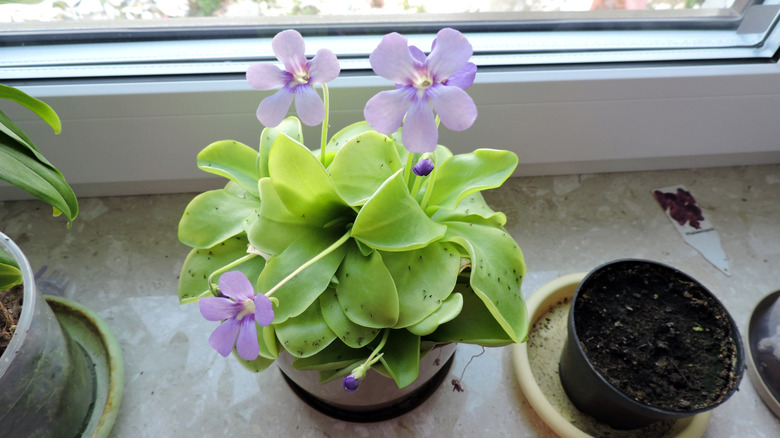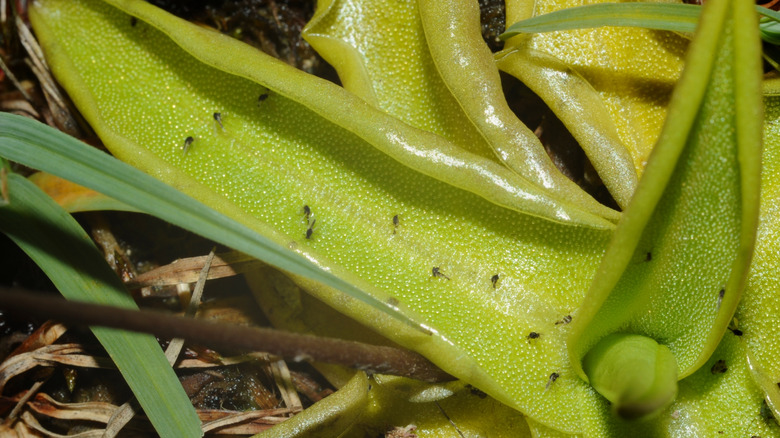The Best Way To Care For Your Indoor Pinguicula Plant
With the humdrummery of adulting, we all need reminders of things that spark childlike delight. Chances are you haven't thought about carnivorous plants since elementary school. Adorably nicknamed "pings", pinguicula plants are among the green things that feast on insects. Its cute nickname and carnivory aside, pinguiculas make attractive, practical, and fascinating houseplants. Pings' unusual characteristics do require a bit of special treatment, from soil to watering to their occasional insect snack.
Pinguiculas, also known as butterworts, are well-suited for indoor pot living. Their light-green leafy rosettes give them the look of a succulent, and their delicate flowers appear in lavender, purple, pink, fuchsia, red, or white. To keep these unique-looking houseplants pretty and healthy, they need low-nutrient growing medium, proper lighting, pure water, and an insect or two a week. If this sounds daunting, don't let these particular needs turn you away. Pinguiculas have enough winning qualities to deserve the extra effort.
This plant can help banish fungus gnats from your home. Meet the ping's thirst for blood by placing it near plants afflicted with these pests. Like sticky traps you can purchase, pings' leaves are stocked with a gluey substance that insects can't escape from. If indoor insects don't plague your home, there are other food options. Show it the right care, and your pinguicula may bloom twice a year.
Make your pinguicula flourish
So, you've decided to bring a ping into your home. You can start them from seed, purchase bare-root plants, or find plants already potted in the right kind of pots and medium. Seeds planted in the substrate mix can take between 4 and 6 weeks to sprout, so if you're impatient, opt for bare root or potted pings.
Protect your investment by mixing up a growing mix or purchasing a substrate designed for carnivorous plants; this mixture doesn't contain much organic matter. , There are some pretty convincing reasons why you shouldn't use peat moss, though many substrate recipes call for it. Preserve resources by subbing this unsustainable ingredient for sphagnum. Mix two parts sphagnum to one part both sand and vermiculite. If this sounds like a pain, purchase a ready-made mix that contains sphagnum instead of peat.
Place this mixture and your ping in a plastic or glazed ceramic pot; terra cotta causes plants to dry out too quickly. Set the pot on a watering tray as well, since top watering can damage leaves. Situate your ping in a sunny spot near an east- or west-facing window, preferably near plants with fungus gnat or aphid infestations. Keep the soil moist with distilled water, rainwater, or water treated by reverse osmosis. The minerals in tap or well water will harm pings. If they're around, let your ping catch fungus gnats on its own. If not, pings can get by with just sunlight and critters that naturally live in their growing medium. You can also put small amounts of fish food or meal worms on their leaves every 2 to 3 weeks.
Pitfalls for ping owners
Carnivorous plants have a reputation for being hard to raise. Luckily, pings are among the easier ones to care for as long as you continue to give your ping the right kind of attention. Pings like moist surroundings, both soil and air. Keep a little under a ½ inch of water in the plant's tray at all times for constant absorption. If your home's air is particularly dry, running a humidifier near the ping is beneficial. Pings also grow well in terrariums with LED lighting, as long as there is proper air flow.
In winter, some plants' carnivorous leaves die off and are replaced with succulent leaves. This is normal, since it evolved to store water during the dry seasons in its native habitat. Instead, let the soil dry fully between watering. You also won't need to feed the plant insects during this phase.
Don't get too hung up on the carnivory; worry about your plant's bug supply only after you've taken care of the light, soil, and moisture factors. In fact, bug eating can harm a ping if it's not in optimal health, since it takes lots of energy for the plant to digest insects. Treat one of your ping's leaves to "meat" no more often than once a week, and make sure it's not larger than one third its leaves' width. You might discover that the leaves aren't sticky enough to catch flies. This is a sign of a moisture deficiency. A humidifier and closer attention to water levels in the tray should solve this.

